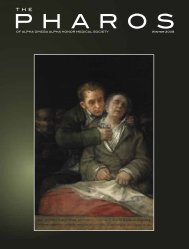The Pharos - Alpha Omega Alpha
The Pharos - Alpha Omega Alpha
The Pharos - Alpha Omega Alpha
You also want an ePaper? Increase the reach of your titles
YUMPU automatically turns print PDFs into web optimized ePapers that Google loves.
Daylon<br />
Joseph Chiovaro, MD<br />
<strong>The</strong> author (AΩA, University of<br />
Washington, 2006) is an assistant<br />
professor of Medicine at the Oregon<br />
Health & Science University and<br />
Portland VA Medical Center.<br />
You have been a good teacher<br />
today. <strong>The</strong> patients are always<br />
our best teachers.” <strong>The</strong> young<br />
pediatric resident is ostensibly speaking<br />
to a twenty-two-year-old mother<br />
whose second child is in the hospital<br />
with severe respiratory distress. <strong>The</strong> six<br />
students he is leading around for the<br />
morning, acolytes to the altar of medical<br />
education, know these stock phrases are<br />
for our benefit. <strong>The</strong> mother smiles back<br />
a colorless smile, also mostly for our<br />
benefit. I feel as though I am watching<br />
an Arthur Miller play, the characters<br />
moving through scenes they can’t control.<br />
<strong>The</strong>re is an awkward pause in the<br />
conversation, the insincerity and disingenuousness<br />
of the comment taking on<br />
a life of its own. That’s how you know<br />
he’s a resident.<br />
<strong>The</strong> mother doesn’t care about being<br />
a teacher. She doesn’t care about<br />
helping to educate the “doctors of tomorrow.”<br />
She is simply a scared single<br />
mother who didn’t know how to say no<br />
when some pleasant woman came to<br />
the room earlier that morning to ask<br />
if it would be all right to bring medical<br />
students by. All she wants is for her<br />
baby to breathe better. Five-month-old<br />
Daylon, a beautiful, curly haired child,<br />
is enmeshed in the tubes and machines<br />
of modern medicine. During our interview<br />
with the mother, her eyes flit<br />
constantly back to him. I can almost feel<br />
her suffering as she watches Daylon’s<br />
nostrils flare and chest squeeze with<br />
each breath. I can see the corners of her<br />
mouth fleetingly twitch—a consciously<br />
aborted grimace—every time Daylon<br />
grunts to breathe.<br />
But maybe my imagination is just<br />
playing tricks on me. Maybe she is as<br />
calm as she appears. After all this is the<br />
third time in Daylon’s short life that he<br />
has been in the hospital.<br />
I tune in just long enough to hear,<br />
“So with vaccinations current and up<br />
to date, and given the time of year, RSV<br />
would be high on the differential. . . .”<br />
I need to focus. This is information<br />
I need to know, but somehow I keep<br />
coming back to Daylon and his mother.<br />
Differential diagnoses and pathophysiology<br />
somehow seem less important.<br />
Daylon is big for his age, one of those<br />
chubby infants people invariably describe<br />
as “cute.” His hair is a brown curly<br />
mop that stands in all directions, in<br />
complete defiance of gravity. He looks<br />
healthy, though troubled in his sleep.<br />
His mother is thin with light brown<br />
skin and bright eyes, beautiful beneath<br />
the veil of weary motherhood. Her top<br />
is slightly revealing, and I avert my eyes<br />
only to notice that among her various<br />
tattoos, there are two that claim devotion<br />
to two different men. I wonder if<br />
one is Daylon’s daddy. I wonder if he<br />
is worried about Daylon right now, but<br />
I doubt it. During the interview, she<br />
made it clear that his father was not in<br />
the picture.<br />
As medical students, our interviews<br />
spare nothing. We are taught to inquire<br />
about sex, drugs, money, social<br />
relationships—all the juicy details of<br />
being human that make for good daytime<br />
television. Daylon’s mother is on<br />
welfare; she has no real plans to ever<br />
be otherwise. She lives in an apartment<br />
with her two children, and is not worried<br />
about finances because, she says<br />
with smiling bravado, “It always seems<br />
to work out somehow.” We smile back,<br />
trying desperately to convey that we<br />
understand, but we don’t. We are bright<br />
and well educated people for whom<br />
opportunities abound. How could we<br />
understand her struggles? She smiles<br />
back, understanding the absurdity, but<br />
appreciating the good intentions.<br />
Because of Daylon’s respiratory problems,<br />
we are all wearing bright yellow<br />
full-length gowns with masks over our<br />
faces—physical barriers that are fitting<br />
analogies to the social and cultural barriers<br />
in the room. Earlier in the morning<br />
we had watched videos that stressed the<br />
importance of the doctor-patient-parent<br />
relationship in pediatrics, and lectured<br />
us on how we needed to “break down<br />
the barriers to communication.”<br />
<strong>The</strong> resident continues to talk<br />
through the physical exam: “So you can<br />
<strong>The</strong> <strong>Pharos</strong>/Autumn 2012 29














